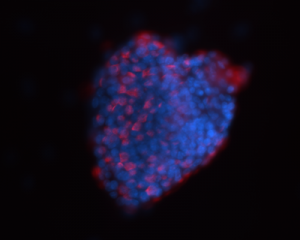When we accidentally burn ourselves while cooking or nick our fingers on a piece of paper, most of us experience a fleeting moment of irritation but never worry that the wound won’t heal. Our everyday lives have taught us that skin is a tissue with great regenerative capability.
Unfortunately, the merits of self-healing seem to have been lost upon our hearts.
Studies suggest that only ~1% of cardiomyocytes (heart muscle cells) are replaced per year in young adults and that this declines with age. While some cell division near the affected area may be stimulated following a heart attack, it doesn’t come close to replenishing the millions of cells that may have perished during the ischemic onslaught. For this reason, a number of labs have been trying to develop cell therapies and tissue engineered grafts to replace the lost cardiac tissue. Interestingly, a paper just published in Nature by Eulalio et al. at the University of Trieste, shows promise with a much different approach that uses one of my favourite types of molecule, the microRNA (miRNA).
For those unfamiliar, miRNAs are short, ~22 base pair RNA molecules that are encoded by our genomes. They function to regulate cellular physiology by blocking the production of specific proteins. Within the last 10 years, we have come to recognize the existence of over 1500 miRNAs, but we are only just beginning to understand their physiological roles. Some of the challenge comes from the fact that each miRNA can regulate the production of 100s-1000s of proteins. Clearly, they perform complex and powerful regulatory roles – could they be used to revert adult cardiomyocytes to a pro-proliferative state?
According to Eulalio et al., the answer is yes.
In their study, the authors take a fairly comprehensive and unbiased approach by initially screening a library of 875 rat miRNA mimics for their ability to promote cardiomyocyte proliferation. After multiple rounds of screening in a few different cell lines, they were able to hone in on two miRNAs, hsa-miR-590 and hsa-miR-199a, that could promote proliferation of adult cardiomyocytes in vitro. Importantly, they then show that overexpression of these miRNAs could preserve cardiac function in mouse models of myocardial infarction.
I’m rather “pumped” about this study because it could contribute to several types of therapeutic interventions for ischemic damage. Although viral vectors were used to introduce the miRNA-encoding DNA to the hearts in this study, as discussed in my last blog, the development of non-viral DNA delivery mechanisms has been an intense area of research since iPSc technology was developed. Even if direct introduction of miRNAs to the affected area proves unfeasible, Mark Mercola makes a salient point in his editorial article that if we learn more about the pathways these miRNAs are affecting, we could potentially design drugs that also target these pathways. Alternatively, since these miRNAs might stimulate a number of pathways that one drug might be unable to accomplish alone, one could ask – can we design a drug that will simply stimulate these miRNAs? You could also take direct advantage of them to expedite ex vivo cardiac tissue engineering.
Forgive the researcher in me for spilling ideas all over the table, but it’s exciting to think that these miRNAs could help us to take control over the recovery of our hearts following damage. A number of our other organs also exist in a non-dividing state after birth, and perhaps these can be “micro-managed” as well.
Holly Wobma
Latest posts by Holly Wobma (see all)
- Relay race to finish off inflammatory cells - July 12, 2017
- What time zone is your heart tissue In? - June 19, 2017
- Filling the void: A scientist’s introduction to commercialization/clinical translation - April 26, 2017







Comments